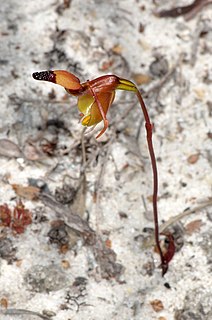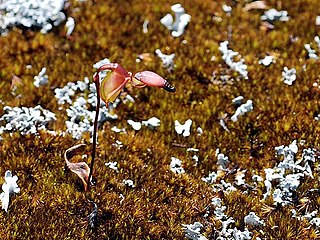
Caleana, commonly known as duck orchids, is a genus of flowering plants in the orchid family, Orchidaceae that is found in Australia and New Zealand. The Australian species are found in all states but have not been recorded in the Northern Territory. Duck orchids have a single leaf and one or a few, dull-coloured, inconspicuous flowers. Most species are found in Western Australia but one species occurs in eastern Australia and one occurs in eastern Australia and New Zealand. Orchids in this genus as well as the hammer orchids (Drakaea) are pollinated by male thynnid wasps.
Caladenia evanescens, commonly known as the semaphore spider orchid, is a species of orchid endemic to a small area near Albany in the south-west of Western Australia. It is a rare species with a single, hairy leaf and one or two cream-coloured to greenish-cream flowers.
Caladenia graminifolia, commonly known as the grass-leafed spider orchid is a species of orchid endemic to the south-west of Western Australia. It has a single glabrous leaf and one or two short-lived, greenish-yellow and red flowers which have a narrow labellum with long teeth on its sides.
Caladenia graniticola, commonly known as the Pingaring spider orchid, is a species of orchid endemic to the south-west of Western Australia. It has a single, hairy leaf and one or two yellowish-green, red and white flowers which have a greenish-yellow and white labellum with a red tip. It was originally described as Caladenia hoffmanii subsp. graniticola but has a slightly different labellum and column.
Caladenia voigtii, commonly known as the mohawk orchid, is a species of orchid endemic to the south-west of Western Australia. It has a single erect, hairy leaf and usually only one greenish-yellow and red flower. When discovered near Salmon Gums in 1977, it was thought to be the extinct Caladenia cristata, but when C. cristata was found near Miling, the Salmon Gums discovery was renamed C. voigtii.

Caleana nigrita, commonly known as the small duck orchid or flying duck orchid is a species of orchid endemic to the south-west of Western Australia. It is the most common of the flying duck orchids and has the widest distribution of the Western Australian species. It has a single smooth leaf and is distinguished from the others by its labellum which has a hump in the middle and calli covering two thirds of its outer end. Its dull colouration makes it difficult to find, especially in areas that are blackened by fire.
Prasophyllum odoratissimum, commonly known as the scented leek orchid or fragrant leek orchid, is a species of orchid endemic to Western Australia. It has a single smooth, tubular leaf and up to thirty or more scented, greenish, white and fawn-coloured flowers with a labellum which is often bent backwards. It was formerly included in Prasophyllum odoratum.
Caleana alcockii, commonly known as Alcock's duck orchid is a rare species of orchid endemic to the south-west of Western Australia. It has a single smooth leaf and is distinguished by its humped labellum and relatively late flowering period. It only occurs north of Geraldton.

Caleana brockmanii, commonly known as Brockman's duck orchid is a species of orchid endemic to the south-west of Western Australia. It has a single smooth leaf, a single greenish yellow and red flower and is distinguished by its flat labellum, relatively late flowering period and calli only near the tip of the labellum. It is found south from Perth.

Caleana triens, commonly known as broad-billed duck orchid is a species of orchid endemic to the south-west of Western Australia. It has a single smooth leaf and is distinguished by its flattened labellum with calli only near its tip and by its relatively early flowering period.
Caleana disjuncta, commonly known as the little duck orchid, is a species of orchid that is found in Western Australia but with a few disjunct populations in Victoria and South Australia. It has a single smooth leaf and a single greenish yellow and red flower with a flattened labellum, the calli only near its tip.
Caleana dixonii, commonly known as the sandplain duck orchid is a rare species of orchid endemic to the south-west of Western Australia. It has a single smooth leaf and a single greenish yellow and fawn-coloured flower. It is distinguished by its flattened labellum with calli only near the tip of the labellum and its preference for growing on sandplains.

Caleana granitica, commonly known as the granite duck orchid is a species of orchid that is endemic to the south-west of Western Australia. It is a species of duck orchid with a single smooth leaf and a single greenish yellow and red flower with the labellum held below the horizontal. It grows on a single granite outcrop near Armadale.

Caleana hortiorum, commonly known as Hort's duck orchid is a species of orchid endemic to the south-west of Western Australia. It has a single smooth leaf, a single greenish yellow and red flower and is distinguished by its long, narrow, slightly humped labellum, with calli on its outer half. It is found between Perth and Albany.
Pterostylis orbiculata, commonly known as the coastal banded greenhood, is a plant in the orchid family Orchidaceae and is endemic to the south-west of Western Australia. The plants either have a rosette of leaves in the years when not flowering or stem leaves on a flowering spike. When flowering, it has up to twenty flowers that are reddish brown, greenish brown or green with a reddish or brownish labellum with short stiff hairs.
Caleana lyonsii, commonly known as the midget duck orchid is a species of orchid endemic to the south-west of Western Australia. It has a single smooth narrow leaf, up to ten greenish yellow flowers. It is distinguished by its narrow leaf which is usually withered by flowering time and its up to ten small, greenish flowers. It grows in harsh environments in disjunct populations between Kalbarri and Southern Cross and has the smallest flowers of its genus in Western Australia.
Caleana parvula, commonly known as the Esperance duck orchid is a species of orchid endemic to a small area near Esperance in the south-west of Western Australia. It has a single smooth leaf and usually only a single greenish yellow and red flower. It is distinguished by its small flower with the calli only on the outer one-fifth of the labellum. The only other Caleana species in Western Australia which is smaller is C. lyonsii.
Caleana terminalis, commonly known as smooth-billed duck orchid is a species of orchid endemic to a small area near the Murchison River in the south-west of Western Australia. It has a single smooth leaf and usually only a single greenish yellow and red flower. It is distinguished by its slightly humped labellum, with calli only on its outer one fifth.
Eriochilus dilatatus subsp. multiflorus, commonly known as the common bunny orchid, is a plant in the orchid family Orchidaceae and is endemic to Western Australia. It has a single short, smooth, flattened, egg-shaped leaf and up to twenty dull green, red and white flowers which are often closely packed. It grows in forest and woodland between Perth and Albany.
Eriochilus tenuis, commonly known as the slender bunny orchid, is a plant in the orchid family Orchidaceae and is endemic to Western Australia. It has a single egg-shaped leaf lying flat on the ground and one or two small pink or pink and white flowers. A common species, it grows in dense, shrubby forest and in winter-wet swamps.







